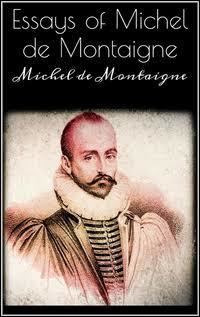8.4 /10 1 Votes8.4
Original title Essais Publication date March 1580 Originally published March 1580 | 4.2/5 Goodreads | |||||||||||||||||||||||||||||||||
 | ||||||||||||||||||||||||||||||||||
Publisher Simon Millanges, Jean Richer Similar Michel de Montaigne books, Essays, Philosophy books | ||||||||||||||||||||||||||||||||||
The Essays (French: Essais, [esɛ]) of Michel de Montaigne are contained in three books and 107 chapters of varying length. Montaigne's stated design in writing, publishing and revising the Essays over the period from approximately 1570 to 1592 was to record "some traits of my character and of my humours." The Essays were first published in 1580 and cover a wide range of topics.
Contents
Style
Montaigne wrote in a rather crafted rhetoric designed to intrigue and involve the reader, sometimes appearing to move in a stream-of-thought from topic to topic and at other times employing a structured style which gives more emphasis to the didactic nature of his work. His arguments are often supported with quotations from Ancient Greek, Latin and Italian texts such as De rerum natura by Lucretius and the works of Plutarch.
Content
Montaigne's stated goal in his book is to describe man, and especially himself, with utter frankness and honesty ("bonne foi"). He finds the great variety and volatility of human nature to be its most basic features, which resonates to the Renaissance thought about the fragility of humans. According to the scholar Paul Oskar Kristeller, "the writers of the period were keenly aware of the miseries and ills of our earthly existence". A representative quote is "I have never seen a greater monster or miracle than myself."
He opposed European colonization of the Americas, deploring the suffering it brought upon the natives.
Citing the case of Martin Guerre as an example, he believes that humans cannot attain certainty. His skepticism is best expressed in the long essay "An Apology for Raymond Sebond" (Book 2, Chapter 12) which has frequently been published separately. We cannot trust our reasoning because thoughts just occur to us: we don't truly control them. We do not have good reasons to consider ourselves superior to the animals. He is highly skeptical of confessions obtained under torture, pointing out that such confessions can be made up by the suspect just to escape the torture he is subjected to. In the middle of the section normally entitled "Man's Knowledge Cannot Make Him Good," he wrote that his motto was "What do I know?". The essay on Sebond defended Christianity. Montaigne also eloquently employed many references and quotes from classical Greek and Roman, i.e. non-Christian authors, especially the atomist Lucretius.
Montaigne considered marriage necessary for the raising of children, but disliked the strong feelings of romantic love as being detrimental to freedom. One of his quotations is "Marriage is like a cage; one sees the birds outside desperate to get in, and those inside desperate to get out."
In education, he favored concrete examples and experience over the teaching of abstract knowledge that is expected to be accepted uncritically. Montaigne's essay "On the Education of Children" is dedicated to Diana of Foix.
The remarkable modernity of thought apparent in Montaigne's essays, coupled with their sustained popularity, made them arguably the most prominent work in French philosophy until the Enlightenment. Their influence over French education and culture is still strong. The official portrait of former French president François Mitterrand pictured him facing the camera, holding an open copy of the Essays in his hands.
Chronology
Montaigne heavily edited Essays at various points in his life. Sometimes he would insert just one word, while at other times he would insert whole passages. Many editions mark this with letters as follows:
A copy of the fifth edition of the Essais with Montaigne's own "C" additions in his own hand exists, preserved at the Municipal Library of Bordeaux (known to editors as the "Bordeaux Copy"). This edition gives modern editors a text dramatically indicative of Montaigne's final intentions (as opposed to the multitude of Renaissance works for which no autograph exists). Analyzing the differences and additions between editions show how Montaigne's thoughts evolved over time. Remarkably, he does not seem to remove previous writings, even when they conflict with his newer views.
